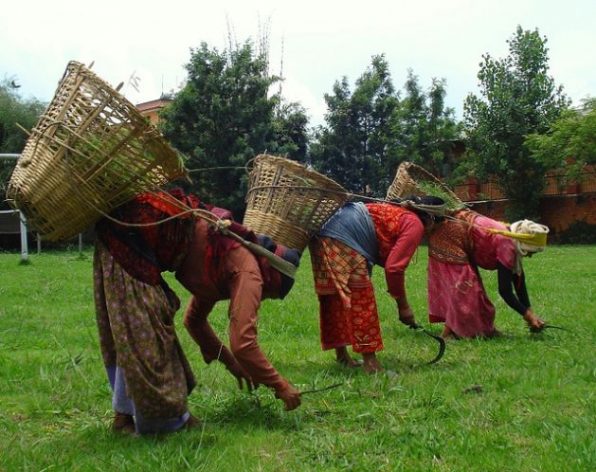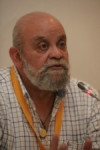Rural Women Work the Hardest, Produce the Most, Eat the Least
TRANSCEND MEMBERS, 24 Oct 2022
Baher Kamal | Human Wrongs Watch - TRANSCEND Media Service
17 Oct 2022 – Make no mistake. Violence against women has been perpetuated, specially when it comes to those who have already been deprived of their basic human rights, as it is the case of rural women in over two-thirds of the world.

Rural women are less able to access land, credit, agricultural inputs, markets, and high-value agrifood chains and obtain lower prices for their crops.
Credit: Mallika Aryal/IPS
While gender-based abuses continue to be extended also in the industrialised societies, women in impoverished countries are still the hardest hit.
Did you know that smallholder agriculture produces nearly 80% of food in Asia and sub-Saharan Africa and supports the livelihoods of some 2.5 billion people?
And that in many parts of Africa and Asia women produce more than 50% of all food?
Yet they face significant discrimination when it comes to land and livestock ownership, equal pay, participation in decision-making entities, and access to resources, credit and market.
Heavy workloads, no rights
Moreover, rural women in these regions have also to bear with the current alarming increases in gender-based violence, transactional sex for food and survival, child marriage (with girls forced to leave school), and unpaid care and domestic workloads.
Furthermore, rural women in poor regions are often left alone as males are recruited and killed in armed conflicts or obliged to migrate.
In such cases, women are forced to bear the entire responsibility of keeping alive their numerous families, from care to food, while often eating the last and the least.
International Day of Rural Women
The above mentioned facts, among others, have been highlighted on the occasion of this year’s International Day of Rural Women on 15 October. See more:
- Rural women are less able to access land, credit, agricultural inputs, markets, and high-value agrifood chains and obtain lower prices for their crops,
- Structural barriers and discriminatory social norms continue to constrain women’s decision-making power and participation in rural households and communities.
- Women and girls in rural areas lack equal access to productive resources and assets, public services, such as education and health care, and infrastructure, including water and sanitation,
- Much of their labour remains invisible and unpaid, even as their workloads become increasingly heavy due to the out-migration of men.
- Globally, with few exceptions, every gender and development indicator for which data are available reveals that rural women fare worse than rural men and urban women,
- Rural women disproportionately experience poverty, exclusion, and the effects of climate change.
In short, women account for a substantial proportion of the agricultural labour force, including informal work, and perform the bulk of unpaid care and domestic work within families and households in rural areas.
Two related world days
The focus on the harsh living conditions of rural women has been flashed out just one day before this year’s World Food Day (16 October), and two days earlier to the 2022 International Day for the Eradication of Poverty (17 October).
In either case, the Days remind that millions of people around the world cannot afford a healthy diet, putting them at high risk of food insecurity and malnutrition.
“But ending hunger isn’t only about supply. Enough food is produced today to feed everyone on the planet.”
In its recent reports: A World of One Billion Empty Plates, and Millions of Girls Abused in the Name of Toxic Masculinity, IPS has exposed how rising, cruel inequalities further push billions of humans into deeper impoverishment hitting girls and women the most.
Nevertheless, far from addressing such a grim reality, the world’s biggest war lords continue to spend on weapons in just one year, the equivalent to the budget of the largest humanitarian body–the United Nations for over a long half a century.
_____________________________________________
 Baher Kamal, a member of the TRANSCEND Network for Peace Development Environment, is an Egyptian-born, Spanish national, secular journalist, with over 45 years of professional experience — from reporter to special envoy to chief editor of national dailies and an international news agency. Baher is former Senior Advisor to the Director General of the international news agency IPS (Inter Press Service) and he also contributed to prestigious magazines such as TRANSCEND Media Service, GEO, Muy Interesante, and Natura, Spain. He is also publisher and editor of Human Wrongs Watch.
Baher Kamal, a member of the TRANSCEND Network for Peace Development Environment, is an Egyptian-born, Spanish national, secular journalist, with over 45 years of professional experience — from reporter to special envoy to chief editor of national dailies and an international news agency. Baher is former Senior Advisor to the Director General of the international news agency IPS (Inter Press Service) and he also contributed to prestigious magazines such as TRANSCEND Media Service, GEO, Muy Interesante, and Natura, Spain. He is also publisher and editor of Human Wrongs Watch.
Go to Original – human-wrongs-watch.net
Tags: Agriculture, Women, Women Rights, Women liberation
DISCLAIMER: The statements, views and opinions expressed in pieces republished here are solely those of the authors and do not necessarily represent those of TMS. In accordance with title 17 U.S.C. section 107, this material is distributed without profit to those who have expressed a prior interest in receiving the included information for research and educational purposes. TMS has no affiliation whatsoever with the originator of this article nor is TMS endorsed or sponsored by the originator. “GO TO ORIGINAL” links are provided as a convenience to our readers and allow for verification of authenticity. However, as originating pages are often updated by their originating host sites, the versions posted may not match the versions our readers view when clicking the “GO TO ORIGINAL” links. This site contains copyrighted material the use of which has not always been specifically authorized by the copyright owner. We are making such material available in our efforts to advance understanding of environmental, political, human rights, economic, democracy, scientific, and social justice issues, etc. We believe this constitutes a ‘fair use’ of any such copyrighted material as provided for in section 107 of the US Copyright Law. In accordance with Title 17 U.S.C. Section 107, the material on this site is distributed without profit to those who have expressed a prior interest in receiving the included information for research and educational purposes. For more information go to: http://www.law.cornell.edu/uscode/17/107.shtml. If you wish to use copyrighted material from this site for purposes of your own that go beyond ‘fair use’, you must obtain permission from the copyright owner.